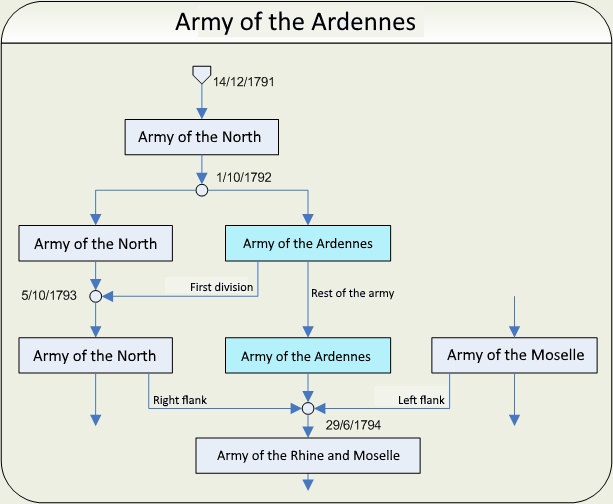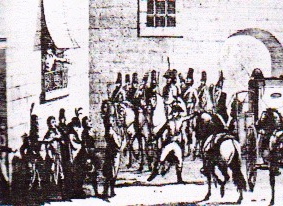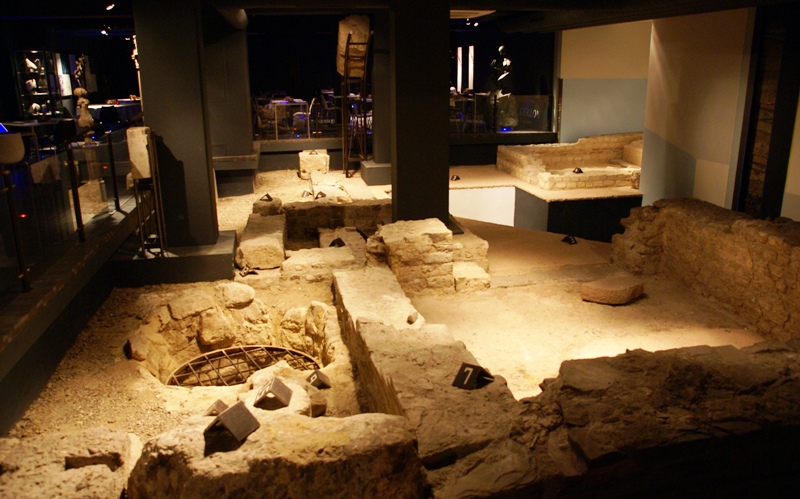|
Louis Charbonnier
Louis Charbonnier (9 October 1754 – 2 June 1833) was a general of mediocre talent who commanded a French army for several months during the French Revolutionary Wars. In 1780 he enlisted in the French Royal Army. With the advent of the French Revolution his promotion became very rapid. In 1792 he was elected second in command of a volunteer battalion. He led his troops at Jemappes and Neerwinden. He was promoted to general of brigade in November 1793 and general of division in January 1794. A week later he was appointed commander-in-chief of the ''Army of the Ardennes''. In May and June 1794, Charbonnier and Jacques Desjardin jointly led an army that tried three times to establish a foothold on the north bank of the Sambre River. After defeats in the battles of Grandreng, Erquelinnes and Gosselies, Charbonnier was recalled to Paris in semi-disgrace on 8 June 1794. After being unemployed for several months, he was assigned to command a series of garrisons in France and Belgium. ... [...More Info...] [...Related Items...] OR: [Wikipedia] [Google] [Baidu] |
Clamecy, Nièvre
Clamecy () is a commune in the Nièvre department in central France. Clamecy is the capital of an arrondissement in the department of Nièvre, at the confluence of the Yonne and Beuvron and on the Canal du Nivernais, N.N.E. of Nevers. Clamecy is locally described as the capital of the valleys of the Yonne and classified under the French tourist criteria "Station Verte de Vacances" (centre for outdoor activity–based vacations) and among the "Plus Beau Détour de France" (most beautiful routes in France). History The earliest literary mention under the name of Clamiciacus, a possession of the bishops of Auxerre, is in the bequest by Pallade, Bishop of Auxerre, in 634, founding an abbey in the suburbs of Auxerre, dedicated to the Virgin, Saint Andrew and Saint Julien, martyr, and supported by lands in Clamiciacus and other places. Clamecy continued to belong to the abbey of St Julian at Auxerre until the eleventh century, when it passed to the counts of Nevers and of Aux ... [...More Info...] [...Related Items...] OR: [Wikipedia] [Google] [Baidu] |
Army Of The Ardennes
The Army of the Ardennes (''armée des Ardennes'') was a French Revolutionary Army formed on the first of October 1792 by splitting off the right wing of the Army of the North, commanded from July to August that year by La Fayette. From July to September 1792 General Dumouriez also misused the name Army of the Ardennes for the right wing of what was left of the Army of the North after the split, encamped at Sedan and the name of Army of the North for the left flank of the army. It was reorganized by a decree of the Conseil exécutif on the first of March 1793, leading to only the right flank of the army keeping the name of Army of the Ardennes. The first division of the Army of the Ardennes re-merged back into the Army of the North on 5 October 1793, at which date the rest of the Army of the Ardennes continued as the Army of the Ardennes until 29 June 1794, when it merged with the Army of the North's right wing and the Army of the Moselle's left wing to form the Army of Sambr ... [...More Info...] [...Related Items...] OR: [Wikipedia] [Google] [Baidu] |
Jean Henri Becays Ferrand
Jean Henri Becays Ferrand or Jean Marie Begais Ferrand de la Caussade (10 September 1736 – 28 November 1805) became a French general officer early in the French Revolutionary Wars and led troops during two early actions. From a noble family, he was enrolled in the French Royal Army as an officer in the ''Normandie'' Infantry Regiment. At the age of ten, he fought at Lauffeld and Bergen op Zoom in the War of the Austrian Succession. In 1760 during the Seven Years' War, he was badly wounded at Kloster Kampen. For distinguished service, he was promoted to captain. Appointed colonel in 1791, Ferrand was made the commandant of the fortress of Valenciennes the next year. Promoted to maréchal de camp, he led the left wing at the Battle of Jemappes. He was elevated in rank to general of division in May 1793. Ordered by his turncoat superior Charles François Dumouriez to surrender Condé-sur-l'Escaut and Valenciennes, Ferrand refused to carry out his instructions. After the ... [...More Info...] [...Related Items...] OR: [Wikipedia] [Google] [Baidu] |
Charles François Dumouriez
Charles-François du Périer Dumouriez (, 26 January 1739 – 14 March 1823) was a French general during the French Revolutionary Wars. He shared the victory at Valmy with General François Christophe Kellermann, but later deserted the Revolutionary Army, and became a royalist intriguer during the reign of Napoleon as well as an adviser to the British government. Dumouriez is one of the names inscribed under the Arc de Triomphe, on Column 3. Early life Dumouriez was born in Cambrai, on the Scheldt River in northern France, to parents of noble rank. His father, Antoine-François du Périer, served as a commissary of the royal army, and educated his son most carefully and widely. The boy continued his studies in Paris at the ''Lycée Louis-le-Grand'', and in 1757 began his military career as a volunteer in the campaign of Rossbach, where he served as a cornet in the ''Régiment d'Escars''. He received a commission for good conduct in action, and served in the later German cam ... [...More Info...] [...Related Items...] OR: [Wikipedia] [Google] [Baidu] |
Army Of The North (France)
The Army of the North or Armée du Nord is a name given to several historical units of the French Army. The first was one of the French Revolutionary Armies that fought with distinction against the First Coalition from 1792 to 1795. Others existed during the Peninsular War, the Hundred Days and the Franco-Prussian War. Campaigns 1791 to 1797 At the creation of the Army of the North on 14 December 1791, the government of the Kingdom of France appointed Jean-Baptiste Donatien de Vimeur, Comte de Rochambeau, as its commander. Rochambeau was replaced in May 1792, and he retired from service. The suspicious government of the First French Republic later charged him with treason and he barely escaped execution. In 1792-1794, the guillotine awaited military commanders who either failed, belonged to the nobility, or displayed insufficient revolutionary zeal. In the Army of the North these unfortunates included Nicolas Luckner, Adam Custine, and Jean Houchard. Under Charles François ... [...More Info...] [...Related Items...] OR: [Wikipedia] [Google] [Baidu] |
Chef De Bataillon
Major (commandant in certain jurisdictions) is a military rank of commissioned officer status, with corresponding ranks existing in many military forces throughout the world. When used unhyphenated and in conjunction with no other indicators, major is one rank above captain, and one rank below lieutenant colonel. It is considered the most junior of the field officer ranks. Background Majors are typically assigned as specialised executive or operations officers for battalion-sized units of 300 to 1,200 soldiers while in some nations, like Germany, majors are often in command of a company. When used in hyphenated or combined fashion, the term can also imply seniority at other levels of rank, including ''general-major'' or ''major general'', denoting a low-level general officer, and ''sergeant major'', denoting the most senior non-commissioned officer (NCO) of a military unit. The term ''major'' can also be used with a hyphen to denote the leader of a military band such as i ... [...More Info...] [...Related Items...] OR: [Wikipedia] [Google] [Baidu] |
Company (military Unit)
A company is a military unit, typically consisting of 80–250 soldiers and usually commanded by a major or a captain. Most companies are formed of three to seven platoons, although the exact number may vary by country, unit type, and structure. Usually several companies are grouped as a battalion or regiment, the latter of which is sometimes formed by several battalions. Occasionally, ''independent'' or ''separate'' companies are organized for special purposes, such as the 1st Air Naval Gunfire Liaison Company or the 3rd Force Reconnaissance Company. These companies are not organic to a battalion or regiment, but rather report directly to a higher level organization such as a Marine Expeditionary Force headquarters (i.e., a corps-level command). Historical background The modern military company became popularized during the reorganization of the Swedish Army in 1631 under King Gustav II Adolph. For administrative purposes, the infantry was divided into companies consist ... [...More Info...] [...Related Items...] OR: [Wikipedia] [Google] [Baidu] |
Captain (armed Forces)
The army rank of captain (from the French ) is a commissioned officer rank historically corresponding to the command of a company of soldiers. The rank is also used by some air forces and marine forces. Today, a captain is typically either the commander or second-in-command of a company or artillery battery (or United States Army cavalry troop or Commonwealth squadron). In the Chinese People's Liberation Army, a captain may also command a company, or be the second-in-command of a battalion. In some militaries, such as United States Army and Air Force and the British Army, captain is the entry-level rank for officer candidates possessing a professional degree, namely, most medical professionals (doctors, pharmacists, dentists) and lawyers. In the U.S. Army, lawyers who are not already officers at captain rank or above enter as lieutenants during training, and are promoted to the rank of captain after completion of their training if they are in the active component, or after a ... [...More Info...] [...Related Items...] OR: [Wikipedia] [Google] [Baidu] |
National Guard (France)
The National Guard (french: link=no, Garde nationale) is a French military, gendarmerie, and police reserve force, active in its current form since 2016 but originally founded in 1789 during the French Revolution. For most of its history the National Guard, particularly its officers, has been widely viewed as loyal to middle-class interests. It was founded as separate from the French Army and existed both for policing and as a military reserve. However, in its original stages from 1792 to 1795, the National Guard was perceived as revolutionary and the lower ranks were identified with sans-culottes. It experienced a period of official dissolution from 1827 to 1830 but was reestablished. Soon after the Franco-Prussian War of 1870–71, the National Guard in Paris again became viewed as dangerously revolutionary, which contributed to its dissolution in 1871. In 2016, France announced the reestablishment of the National Guard for the second time, in response to a series of te ... [...More Info...] [...Related Items...] OR: [Wikipedia] [Google] [Baidu] |
Names Inscribed Under The Arc De Triomphe
The following is a list of the 660 names inscribed under the Arc de Triomphe, in Paris. Most of them represent generals who served during the French First Republic (1792–1804) and the First French Empire (1804–1815). Underlined names signify those killed in action. Additionally, the names of specific armies are listed, grouped together by the four compass facades of the arch: North (northern France, lower Rhine, Netherlands), East (Central Europe, Switzerland, Italy), South (Mediterranean Europe, Egypt, southern France) and West (Pyrenees, western France, notable units). Related list: Battles inscribed on the Arc de Triomphe. File:Paris Arc de Triomphe inscriptions 2.jpg, Northern pillar Armies of northern France, the lower Rhine and the Netherlands. File:Paris Arc de Triomphe inscriptions 3.jpg, Eastern pillar Armies of Central Europe, Switzerland and Italy. File:Paris Arc de Triomphe inscriptions 7.jpg, Southern pillar Armies of Mediterranean Europe, Egypt and souther ... [...More Info...] [...Related Items...] OR: [Wikipedia] [Google] [Baidu] |
Maastricht
Maastricht ( , , ; li, Mestreech ; french: Maestricht ; es, Mastrique ) is a city and a municipality in the southeastern Netherlands. It is the capital and largest city of the province of Limburg. Maastricht is located on both sides of the Meuse ( nl, Maas), at the point where the Jeker joins it. Mount Saint Peter (''Sint-Pietersberg'') is largely situated within the city's municipal borders. Maastricht is about 175 km south east of the capital Amsterdam and 65 km from Eindhoven; it is adjacent to the border with Belgium and is part of the Meuse-Rhine Euroregion, an international metropolis with a population of about 3.9 million, which includes the nearby German and Belgian cities of Aachen, Liège and Hasselt. Maastricht developed from a Roman settlement (''Trajectum ad Mosam'') to a medieval religious centre. In the 16th century it became a garrison town and in the 19th century an early industrial centre. Today, the city is a thriving cultural and regional hub. It beca ... [...More Info...] [...Related Items...] OR: [Wikipedia] [Google] [Baidu] |
Belgium
Belgium, ; french: Belgique ; german: Belgien officially the Kingdom of Belgium, is a country in Northwestern Europe. The country is bordered by the Netherlands to the north, Germany to the east, Luxembourg to the southeast, France to the southwest, and the North Sea to the northwest. It covers an area of and has a population of more than 11.5 million, making it the 22nd most densely populated country in the world and the 6th most densely populated country in Europe, with a density of . Belgium is part of an area known as the Low Countries, historically a somewhat larger region than the Benelux group of states, as it also included parts of northern France. The capital and largest city is Brussels; other major cities are Antwerp, Ghent, Charleroi, Liège, Bruges, Namur, and Leuven. Belgium is a sovereign state and a federal constitutional monarchy with a parliamentary system. Its institutional organization is complex and is structured on both regional ... [...More Info...] [...Related Items...] OR: [Wikipedia] [Google] [Baidu] |






